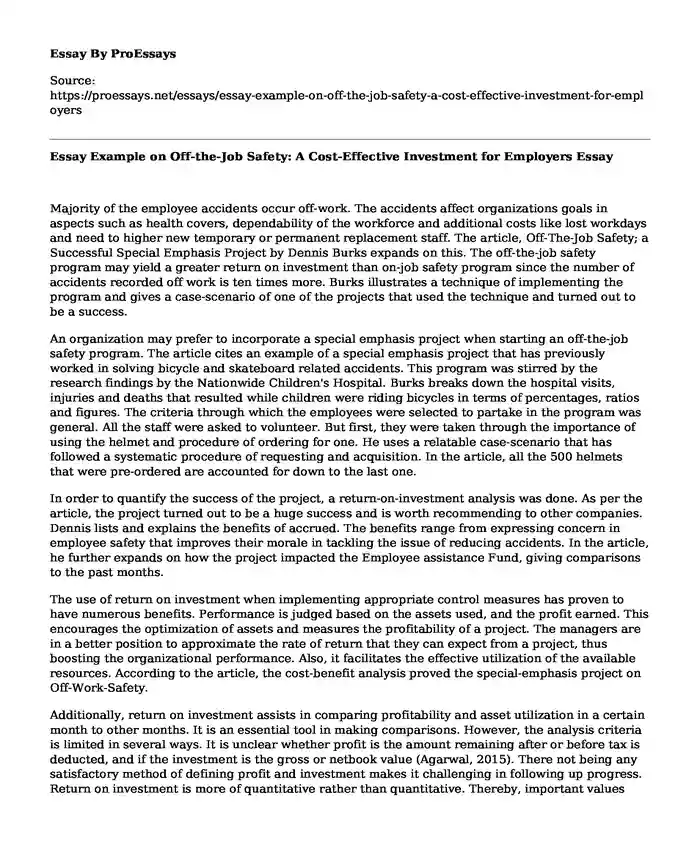Majority of the employee accidents occur off-work. The accidents affect organizations goals in aspects such as health covers, dependability of the workforce and additional costs like lost workdays and need to higher new temporary or permanent replacement staff. The article, Off-The-Job Safety; a Successful Special Emphasis Project by Dennis Burks expands on this. The off-the-job safety program may yield a greater return on investment than on-job safety program since the number of accidents recorded off work is ten times more. Burks illustrates a technique of implementing the program and gives a case-scenario of one of the projects that used the technique and turned out to be a success.
An organization may prefer to incorporate a special emphasis project when starting an off-the-job safety program. The article cites an example of a special emphasis project that has previously worked in solving bicycle and skateboard related accidents. This program was stirred by the research findings by the Nationwide Children's Hospital. Burks breaks down the hospital visits, injuries and deaths that resulted while children were riding bicycles in terms of percentages, ratios and figures. The criteria through which the employees were selected to partake in the program was general. All the staff were asked to volunteer. But first, they were taken through the importance of using the helmet and procedure of ordering for one. He uses a relatable case-scenario that has followed a systematic procedure of requesting and acquisition. In the article, all the 500 helmets that were pre-ordered are accounted for down to the last one.
In order to quantify the success of the project, a return-on-investment analysis was done. As per the article, the project turned out to be a huge success and is worth recommending to other companies. Dennis lists and explains the benefits of accrued. The benefits range from expressing concern in employee safety that improves their morale in tackling the issue of reducing accidents. In the article, he further expands on how the project impacted the Employee assistance Fund, giving comparisons to the past months.
The use of return on investment when implementing appropriate control measures has proven to have numerous benefits. Performance is judged based on the assets used, and the profit earned. This encourages the optimization of assets and measures the profitability of a project. The managers are in a better position to approximate the rate of return that they can expect from a project, thus boosting the organizational performance. Also, it facilitates the effective utilization of the available resources. According to the article, the cost-benefit analysis proved the special-emphasis project on Off-Work-Safety.
Additionally, return on investment assists in comparing profitability and asset utilization in a certain month to other months. It is an essential tool in making comparisons. However, the analysis criteria is limited in several ways. It is unclear whether profit is the amount remaining after or before tax is deducted, and if the investment is the gross or netbook value (Agarwal, 2015). There not being any satisfactory method of defining profit and investment makes it challenging in following up progress. Return on investment is more of quantitative rather than quantitative. Thereby, important values that result from the project might go unnoticed.
Conclusion
In summary, the article gives a systematic procedure of implementing the Off-work-safety concern through Special emphasis project and Return on Investment analysis criteria. Burks breaks down the details in terms of percentages, ratios and figures. Also, it has outlined the benefits accrued from using the ROI analysis technique. However, this technique has several limitations that might have been omitted by the writer. Generally, the article is relevant for organizations interested in implementing new projects.
References
Agarwal, R. (2015, May 13). Return on Investment (ROI): Advantages and Disadvantages. https://www.yourarticlelibrary.com/accounting/return-on-investment-roi-advantages-and-disadvantages/52928.
Cite this page
Essay Example on Off-the-Job Safety: A Cost-Effective Investment for Employers. (2023, Sep 11). Retrieved from https://proessays.net/essays/essay-example-on-off-the-job-safety-a-cost-effective-investment-for-employers
If you are the original author of this essay and no longer wish to have it published on the ProEssays website, please click below to request its removal:
- Effects of Internal Communication to Staff Performance and Overall Business Administration in Corporations
- Generational Differences in the Criminal Justice Workforce Paper Example
- Research Paper on Motivation of Athletes
- Essay on Harrah's Corp: Loveman's Incentive Plan for Employee Motivation
- Motivating Students in the Classroom: Using MUSIC for Success - Essay Sample
- Essay Example on US Firm's Tanzania Business: Cultural Challenges for H.G.
- Essay Example on Interviews: Don't Stop at the First Candidate







